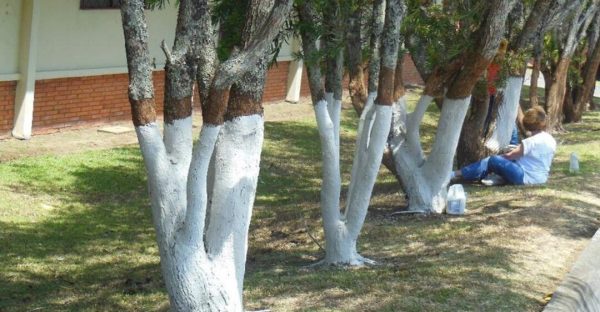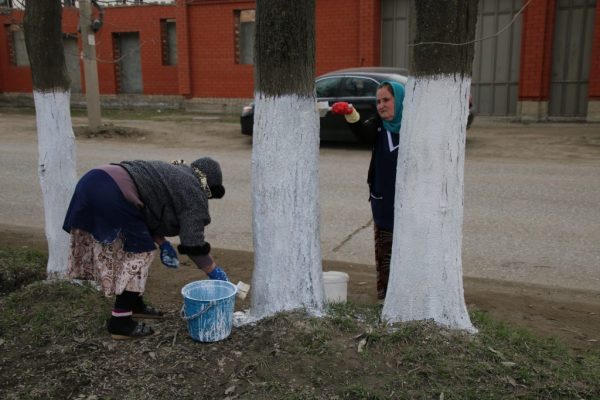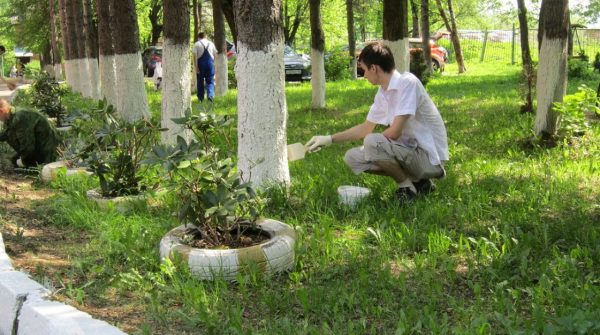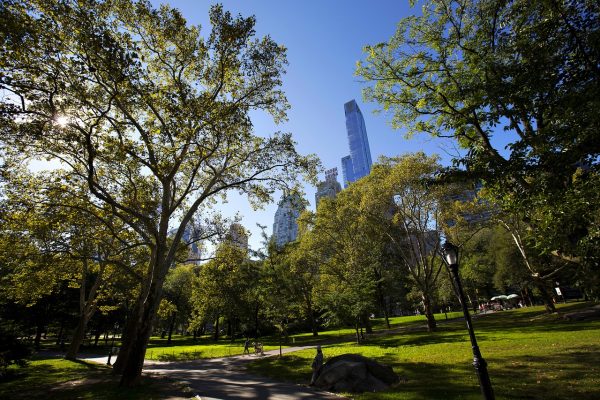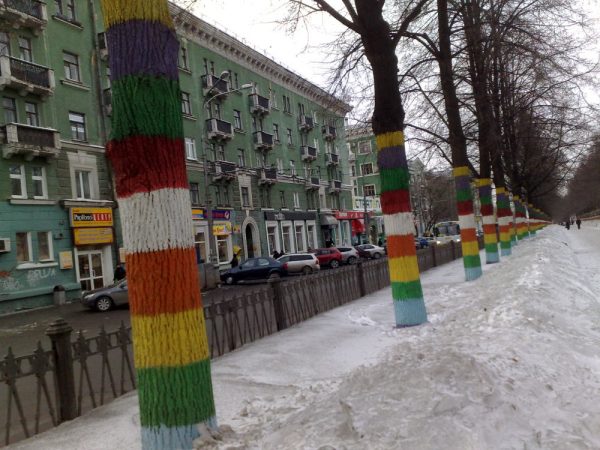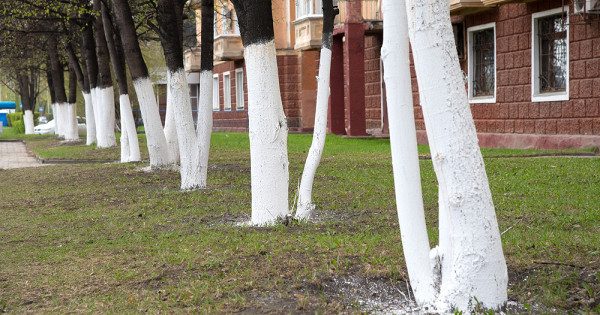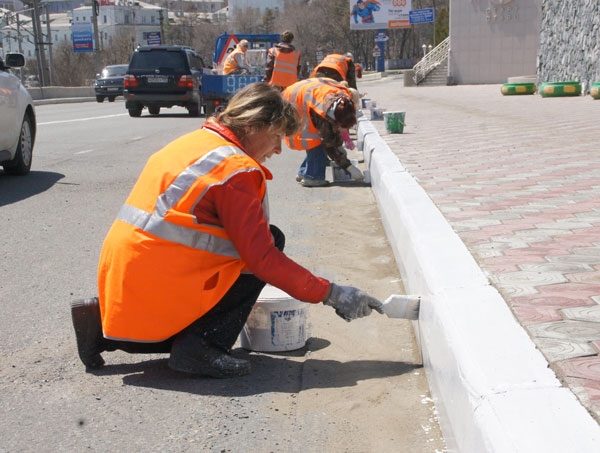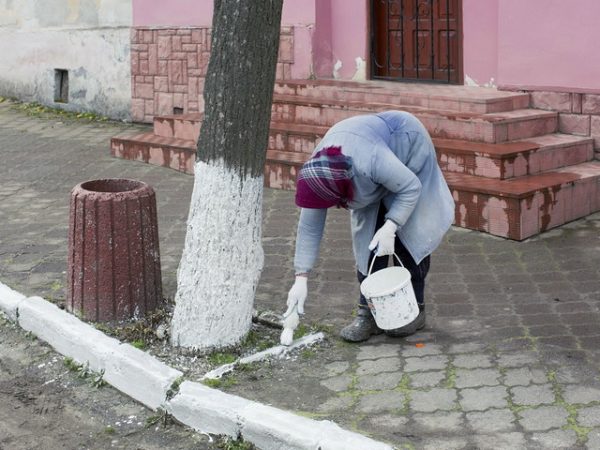A lot of controversy goes about the whitewashing of trees. Old-timers tirelessly insist that it is necessary, because it provides plants with additional protection in the city, but from what? Let us recall that in the wild, neither garden trees nor decorative trees are cultivated, and at the same time they give juicy greens, and without human intervention they even grow into lush flowering forests and groves.
- Do I need to whiten trees in the city?
- What harm does the trees do?
- But if so, then why continue to whitewash?
- Echoes of the past
- How with that abroad
- But what about pest control?
- Trees paint in Africa
- By law, trees cannot be painted
- Why paint borders in the yards
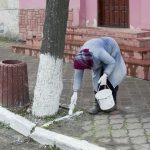
Whitewashing of trees in the spring is a relic of time, no more. In some cases, it is really allowed. For example, it helps to protect immature young seedlings, but at the same time a number of rules must be taken into account:
- you can only paint stamb, from the roots to the first branches;
- slaked lime solution should not be concentrated and caustic, and if you add any additional substances (laundry soap, milk, clay) to it, you need to take into account the correct proportions;
- trees should not be whitened not in the spring (as is usually done throughout Russia and the CIS countries), but in late autumn (since processing is of practical importance and really has a protective function).
Do I need to whiten trees in the city?
Many people identify the whitewashing of trees with the improvement of urban architecture, but in reality this is a big mistake, the scale of which extends to the entire post-Soviet space.
There are many examples in Russia, Kazakhstan, Uzbekistan, Ukraine and Belarus, when utilities are actively whitewashing trees, preparing for the May holidays. Most often, this is done for show to simulate violent activity, and the following factors serve as proof of this:
- too weak and non-concentrated solution is used for processing trees, which does not perform any function, including aesthetic;
- trunks are whitewashed bleakly, focusing on non-existent and invented norms (for example, in many areas communal services oblige workers and the population to apply lime to a height of about 20-30 cm from the sidewalk level, as well as to paint the root neck abundantly);
- along with trees, a curbstone and power transmission poles (both concrete and wooden) fall under whitewashing.
What harm does the trees do?
Adult formed plantings need natural gas exchange, which is carried out through the cortex through the smallest pores. How will a person feel if they are wrapped halfway with tape and left for six months? Trees feel the same way.
Violation of gas exchange leads to unpleasant consequences. The root system does not receive the necessary substances coming from the crown, so it weakens, begins to rot and eventually turns into dust. As a result, the branching tree simply does not support its own weight and falls, uprooting the roots and raising the asphalt. You must have witnessed how trees fell right on parked cars. This is the result of incorrect and even illegal whitewashing of trees in the city.
to contents ↑But if so, then why continue to whitewash?
Retraining from the wrong to the right is the hardest.Whitewashing of trees has been preserved since the times of the USSR (then it really had a certain meaning). Therefore, there was a stereotype: without white trunks, borders and pillars, the city looks gray, groomed and dull.
The forces and means spent on annual and useless painting would bring more fruit if they were sent to solve real communal problems:
- improvement of playgrounds;
- competent laying of asphalt;
- creation of parking spaces;
- installation of signs;
- landscaping, etc.
Often, the whitewashing act falls on the reporting period, when it is necessary to show that any work was done to improve the area.
to contents ↑
Echoes of the past
Referring to the times of the Soviet Union, we are talking about creating landmarks. Trees growing along important traffic arteries were covered with white paint so that convoys could move at night with their headlights turned off. In peacetime and in a metropolis, this need has simply become obsolete.
How with that abroad
There are many examples showing that whitewashing is the fate of the post-Soviet space. Let's remember:
- the famous Central Park in New York;
- beautiful Champs Elysees in Paris;
- Kyoto and Okinawa gardens, dotted with sakura blossoms.
In none of the above places do the trees whiten, and at the same time they look aesthetically pleasing, natural and beautiful. There are thousands of similar examples around the world.
to contents ↑But what about pest control?
To prevent bark beetles from causing any harm, chemical solutions are used in civilized countries. They are colorless and non-toxic, making them safe for green spaces.
to contents ↑If the damage from parasites is too great, then tree trunks are wrapped with special materials, reliably protecting them and without damaging the structure.
Trees paint in Africa
This practice exists, but it is the exception rather than the rule. This tradition is observed only in certain tribes, which thus mark the borders of the village.
It is important that the Africans prepare a solution for painting from natural materials that do not harm the trees, and it acquires a bluish-blue hue.
By law, trees cannot be painted
In Russia, there are a number of restrictions prohibiting the painting of trees in the city. Whitewashing is allowed only in places with high sanitary standards. This may be urban landfills, construction sites or public toilets. Near such objects, trees really need protection.
As evidence, we can cite paragraph 3.1.4.19 of the Gosstroy of the Russian Federation. In individual cities, there are a number of own rules. An example is Chelyabinsk. According to the Resolution of the chapter dated December 2, 2004 (No. 2200-p), whitewashing is prohibited in parks and squares, as well as on boulevards.
to contents ↑Why paint borders in the yards
Here, a number of erroneous factors come into force, and the arguments in favor of painting are completely unsubstantiated and not supported by evidence. There is an opinion that a white curbstone visually helps drivers determine the road markings, but this is not so. In Berlin, Barcelona and in many other European cities, this is not practiced, and at the same time, drivers are perfectly oriented in the stream, not cutting each other and not leaving cars in the wrong place.
Painting borders does not improve the appearance of city streets. Imagine what, say, the Charles Bridge in Prague would look if centuries-old cobblestones were densely whitewashed with paint? The same can be said about the narrow streets in Italy, Spain and in many other countries, in which the flavor of historical architecture has been preserved.
In conclusion, it is worth saying the following.Whitewashing is allowed only in very limited cases: if you are a gardener and grow fruit trees. In the city, it is completely meaningless and is nothing more than a relic of a bygone era.

